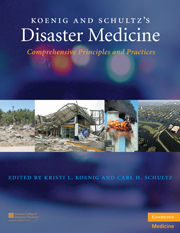Book contents
- Frontmatter
- Contents
- List of Contributors
- Contributor Biographies
- Foreword
- Preface
- Acknowledgments
- PART I CONCEPTUAL FRAMEWORK AND STRATEGIC OVERVIEW
- 1 Disaster Research and Epidemiology
- 2 Disaster Education and Training: Linking Individual and Organizational Learning and Performance
- 3 Surge Capacity
- 4 International Perspectives on Disaster Management
- 5 Ethical Issues in Disaster Medicine
- 6 Emerging Infectious Diseases: Concepts in Preparing for and Responding to the Next Microbial Threat
- 7 Disaster Mental and Behavioral Health
- 8 Special Needs Populations
- PART II OPERATIONAL ISSUES
- PART III CLINICAL MANAGEMENT
- Index
- Plate section
- References
7 - Disaster Mental and Behavioral Health
from PART I - CONCEPTUAL FRAMEWORK AND STRATEGIC OVERVIEW
Published online by Cambridge University Press: 05 August 2011
- Frontmatter
- Contents
- List of Contributors
- Contributor Biographies
- Foreword
- Preface
- Acknowledgments
- PART I CONCEPTUAL FRAMEWORK AND STRATEGIC OVERVIEW
- 1 Disaster Research and Epidemiology
- 2 Disaster Education and Training: Linking Individual and Organizational Learning and Performance
- 3 Surge Capacity
- 4 International Perspectives on Disaster Management
- 5 Ethical Issues in Disaster Medicine
- 6 Emerging Infectious Diseases: Concepts in Preparing for and Responding to the Next Microbial Threat
- 7 Disaster Mental and Behavioral Health
- 8 Special Needs Populations
- PART II OPERATIONAL ISSUES
- PART III CLINICAL MANAGEMENT
- Index
- Plate section
- References
Summary
OVERVIEW
Communities exposed to disasters experience multiple traumatic events including threats to life, loss of property, exposure to death, and often economic devastation. Disasters by definition overwhelm institutions, health care, and social resources and require from months to years for both individuals and communities to recover.
In the aftermath of disasters, human-caused or otherwise, a range of behaviors and symptoms emerge with profound clinical and population-level public health implications. A number of terms have been used to describe the social, psychological, and emotional health of affected populations in the aftermath of disasters and acts of terrorism. “Behavioral and mental health” has emerged as the phrase meant to embrace the broad range of human reactions to disasters. The use of the term “behavior” captures the actions people take to reduce perceived threats to safety, health, and well-being. These coping behaviors also have social and emotional impacts that may alter the extent of loss and change triggered by the disaster or its aftermath.
Characteristics of the disaster event may greatly increase the stress experienced, such as lack of familiarity with the prevailing hazard (e.g., anthrax in the U.S. mail in 2001), use of fear as a weapon (i.e., terrorism), intensity of impact (e.g., degree of direct exposure to harm, loss, and change), predictability of the event (e.g., no warning, inability to avoid, unclear targets, protracted or stuttering course), or caused by human action (purposeful intent to harm vs. accidental).
Keywords
- Type
- Chapter
- Information
- Koenig and Schultz's Disaster MedicineComprehensive Principles and Practices, pp. 103 - 112Publisher: Cambridge University PressPrint publication year: 2009



